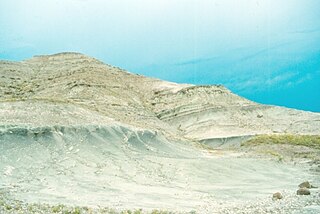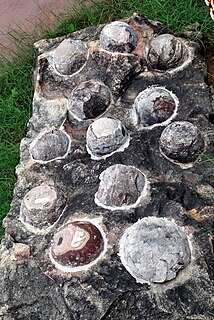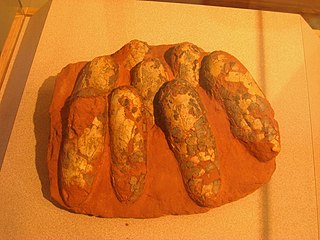| Tubercuoolithus Temporal range: | |
|---|---|
| Egg fossil classification | |
| Oofamily: | incertae sedis |
| Oogenus: | † Tubercuoolithus Jackson and Varricchio, 2010 |
| Oospecies | |
| |
Tubercuoolithus is an oogenus of dinosaur egg from the early Campanian of Montana. [1]
| Tubercuoolithus Temporal range: | |
|---|---|
| Egg fossil classification | |
| Oofamily: | incertae sedis |
| Oogenus: | † Tubercuoolithus Jackson and Varricchio, 2010 |
| Oospecies | |
| |
Tubercuoolithus is an oogenus of dinosaur egg from the early Campanian of Montana. [1]
Tubercuoolithus is so far known only from the Two Medicine Formation in Montana, which is dated to the Campanian. The fossils were found in Teton County, at a locality dated to 80 million years old. [1]
Fossil eggs are very common at the Two Medicine Formation, including the eggs of Troodon and Maiasaura . However, until 2010 no eggs were known from the lower half of that formation. Then, two paleontologists at the University of Montana, Frankie D. Jackson and David J. Varricchio, discovered a fossil egg site at Sevenmile Hill near the base of the formation. These discoveries included Tubercuoolithus, and constituted the oldest fossil eggs known from the Two Medicine. [1]
Tubercuoolithus is similar to the Mongolian elongatoolithids in that its eggshell is composed of calcite and has two layers, a mammillary layer and a cryptoprismatic layer. However, it has quite distinctive ornamentation; the outer surface of Tubercuoolithus's eggshell is covered with domed nodes, arranged in long wavelike patterns (anastomotuberculate) [2] or irregular chains (ramotuberculate). [2] The eggshell thickness (including ornamentation) ranges between 831 µm and 1186 µm. The cryptoprismatic layer is roughly three times thicker than the mammillary layer. The pores are thin and straight. [1]
Because it is known only from fragments, the size and shape of a complete Tubercuoolithus egg are unknown. [1]
It is uncertain which oofamily Tubercuoolithus should be classified in. It is similar in microstructure to Elongatoolithidae, but different in ornamentation. Its ornamentation is similar to that of Montanoolithus . [1]

The Two Medicine Formation is a geological formation, or rock body, in northwestern Montana and southern Alberta that was deposited between 83.5 ± 0.7 Ma and 70.6 ± 3.4 Ma, during Campanian time. It crops out to the east of the Rocky Mountain Overthrust Belt, and the western portion of this formation is folded and faulted while the eastern part, which thins out into the Sweetgrass Arch, is mostly undeformed plains. Below the formation are the nearshore deposits of the Virgelle Sandstone, and above it is the marine Bearpaw Shale. Throughout the Campanian, the Two Medicine Formation was deposited between the western shoreline of the Late Cretaceous Interior Seaway and the eastward advancing margin of the Cordilleran Overthrust Belt. The Two Medicine Formation is mostly sandstone, deposited by rivers and deltas.

Elongatoolithus is an oogenus of dinosaur eggs found in the Late Cretaceous formations of China and Mongolia. Like other elongatoolithids, they were laid by small theropods, and were cared for and incubated by their parents until hatching. They are often found in nests arranged in multiple layers of concentric rings. As its name suggests, Elongatoolithus was a highly elongated form of egg. It is historically significant for being among the first fossil eggs given a parataxonomic name.

Macroelongatoolithus is an oogenus of large, fossil theropod eggs. They are known from Asia and from North America.

Macroolithus is an oogenus of dinosaur egg belonging to the oofamily Elongatoolithidae. The type oospecies, M. rugustus, was originally described under the now-defunct oogenus name Oolithes. Three other oospecies are known: M. yaotunensis, M. mutabilis, and M. lashuyuanensis. They are relatively large, elongated eggs with a two-layered eggshell. Their nests consist of large, concentric rings of paired eggs. There is evidence of blue-green pigmentation in its shell, which may have helped camouflage the nests.
Phaceloolithus is an oogenus of dinosaur egg found in the Fenshui'ao Formation of the Dongting Basin of the Hunan Province of China. The eggs have a subspherical shape, measuring up to 168 mm on the long axis, and having a very thin shell.
Continuoolithus is an oogenus of dinosaur egg found in the late Cretaceous of North America. It is most commonly known from the late Campanian of Alberta and Montana, but specimens have also been found dating to the older Santonian and the younger Maastrichtian. It was laid by an unknown type of theropod. These small eggs are similar to the eggs of oviraptorid dinosaurs, but have a distinctive type of ornamentation.
Ageroolithus is an oogenus of dinosaur egg. It may have been laid by a theropod.
Dispersituberoolithus is an oogenus of fossil egg, which may have been laid by a bird or non-avian theropod.

Egg fossils are the fossilized remains of eggs laid by ancient animals. As evidence of the physiological processes of an animal, egg fossils are considered a type of trace fossil. Under rare circumstances a fossil egg may preserve the remains of the once-developing embryo inside, in which case it also contains body fossils. A wide variety of different animal groups laid eggs that are now preserved in the fossil record beginning in the Paleozoic. Examples include invertebrates like ammonoids as well as vertebrates like fishes, possible amphibians, and reptiles. The latter group includes the many dinosaur eggs that have been recovered from Mesozoic strata. Since the organism responsible for laying any given egg fossil is frequently unknown, scientists classify eggs using a parallel system of taxonomy separate from but modeled after the Linnaean system. This "parataxonomy" is called veterovata.
Sankofa is an oogenus of prismatoolithid egg. They are fairly small, smooth-shelled, and asymmetrical. Sankofa may represent the fossilized eggs of a transitional species between non-avian theropods and birds.
Montanoolithus is an oogenus of fossil egg found in Montana and Alberta. They were probably laid by a dromaeosaur or a caenagnathid.
Microolithus is an oogenus of fossil bird egg from Wyoming, with preserved embryonic remains inside some of its specimens.
Arriagadoolithidae is an oofamily of fossil eggs, representing the eggs of Alvarezsaurs.

Elongatoolithidae is an oofamily of fossil eggs, representing the eggs of oviraptorosaurs. They are known for their highly elongated shape. Elongatoolithids have been found in Europe, Asia, and both North and South America.
Triprismatoolithus is an oogenus of dinosaur egg native to Teton County, Montana. It is classified in the oofamily Arriagadoolithidae, the eggs of alvarezsaurs.
Nipponoolithus is an oogenus of fossil egg native to Japan. It is one of the smallest known dinosaur eggs, and was probably laid by some kind of non-avian maniraptor.
Incognitoolithus is an oogenus of medioolithid fossil bird egg. It is notable for bearing evidence of predation, possibly from a bird pecking the eggshell.

Gobioolithus is an oogenus of fossil bird egg native to Mongolia. They are small, smooth-shelled, and elongated eggs that were first discovered in the 1960s and early 70s during a series of fossil-hunting expeditions in the Gobi desert. Two oospecies have been described: Gobioolithus minor and G. major. The eggs were probably laid in colonial nesting sites on the banks of rivers and lakes.
Pachycorioolithus is an oogenus of small, thin-shelled fossil egg from the early Cretaceous in China. It probably belongs to a bird, though there is a possibility the parent was a non-avian theropod. It was named in 2016, based on a single specimen found in Zhejiang.
Arriagadoolithus is the oogenus of fossil eggs which includes the eggs of the alvarezsaurid Bonapartenykus. Fossils of the creature were found in Patagonia; it may have brooded on its eggs.